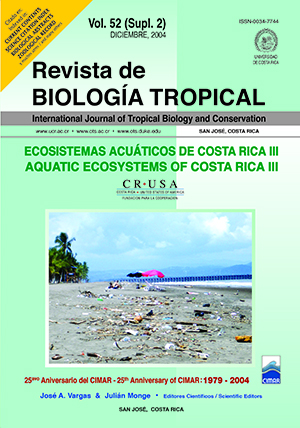Abstract
The spatial and vertical structure of the water currents and its relationship with the tidal cycles were studied using current meters in the Gulf of Nicoya. In the upper gulf, the vertical marine current differences increase as the depth increases. The water column at the station near Chira Island (upper gulf) shows the smaller changes in currents and in temperature. The flow at the station between San Lucas Island and Puntarenas (middle gulf) is the most stratified in this region. Currents with magnitudes over 100 cm/seg were measured during spring tides. Changes in the lags of the surface and bottom tidal flows were measured on the order of 100 minutes. In general, in this upper region the flows are toward the head of the gulf when the tide is flooding and toward the mouth when the tide is ebbing. In the lower gulf the circulation is more complex. Along an axis between Tárcoles and Negritos Islands, changes of velocity vectors are identified between surface and bottom. The current rotates in a different way in the water column in this region and their patterns cannot be explained only by the tidal cycles predicted for Puntarenas. These results demonstrate that the spatial and vertical variation of the marine currents of the Gulf of Nicoya is not only related to the thermohaline structure, but also to the tidal cycles and tide ranges that take place in this estuary.References
Anónimo. 1984. Mapa batimétrico No. 21544. Golfo de Nicoya, Costa Rica. Instituto Geográfico Nacional.
Brenes, C. L., S. León & J. Chaves. 2001. Variación de las propiedades termohalinas en el Golfo de Nicoya, Costa Rica. Rev. Biol. Trop. 49 (Supl 2): 145-152.
Brenes, C. L., S. León & G. Arroyo. 1996. Influence of coastal waters on some physical and chemical oceanographic characteristic of Gulf of Nicoya, Costa Rica. Tóp. Meteorol. y Oceanog.. 3: 65-72.
Dittel, A. I., C. E. Epifanio & O. G. Lizano, l99l. Flux of crab larvae in a mangrove creek in the Gulf of Nicoya, Costa Rica. Estuarine Coastal and Shelf Sci. 32: 129-140.
Emery, W. J. & R. E. Thomson. 2001. Data analysis methods in physical oceanography. Elsevier. New York. 638 p.
Klemas, V., S. G. Ackleson, M. M. Murillo & J. A. Vargas. 1983. Water quality assessment of the Golfo de Nicoya, Costa Rica. Progress report of the 1980-1981. International Sea Grant Program. University of Delaware, College of Marine Studies, Newark. 96 p.
Knauss, J. A. 1978. Introduction to physical oceanography. Prentice. Nueva Jersey. 338 p.
Gocke, K., J. Cortés & M. M. Murillo. 2001. Planktonic primary production in a tidally influenced mangrove forest on the Pacific coast of Costa Rica. Rev. Biol. Trop. 49 (Supl 2): 279-288.
Lizano, O. G. & J. A. Vargas. 1993. Distribución espaciotemporal de temperatura y salinidad en la parte interna del Golfo de Nicoya. Tecnología en Marcha. 12: 3-16.
Lizano, O. G. 1998. Dinámica de la parte interna del Golfo de Nicoya ante altas descargas del Río Tempisque. Rev. Biol. Trop. 46 (Supl 6): 11-20.
León, S., C. L. Brenes, S. Brenner & N. Krees. 1997. Informe final del proyecto: Ecología del Golfo de Nicoya. Universidad Nacional de Costa Rica. 70 p.
Murillo, L. M. 1983. Un modelo para el régimen de intercambio dispersivo en el estrecho de Puntarenas. Tecnología en Marcha. 6: 15-22.
Murillo, L. M. 1990. La circulación de las mareas en el Golfo de Nicoya. Tecnología en Marcha. 10: 51-76.
Peterson, C. L. 1958. The physical oceanography of the Gulf of Nicoya, Costa Rica, a tropical estuary. Bull. Inter. Am. Trop. Tuna Comm. 3: 139-188.
Svendsen, H., R. Rosseland, S. Myking, J. A. Vargas, O. G. Lizano & E. Alfaro. 2004. A physical-oceanographical study of Golfo Dulce. Rev. Biol. Trop. 52 (Supl. 3B): 1-10.
Vargas, J. A. 1995. The Gulf of Nicoya estuary, Costa Rica: past, present, and future cooperative research. Helgolander Meeresunters. 49: 821-828.
Voorhis, A. D., C. E. Epifanio, D. Maurer, A. I. Dittel & J. A. Vargas. 1983. The estuarine character of Gulf of Nicoya, an embayment on the Pacific coast of Central America. Hydrobiologia. 99: 225-237.
Valdez, J., C. L. Brenes, E. Solis & M. Mendelewicz. 1987. Propiedades físico-químicas de las aguas del Golfo de Nicoya, Costa Rica. Ing. Cienc. Quim. 11: 21-25.
##plugins.facebook.comentarios##

This work is licensed under a Creative Commons Attribution 4.0 International License.
Copyright (c) 2004 Revista de Biología Tropical


